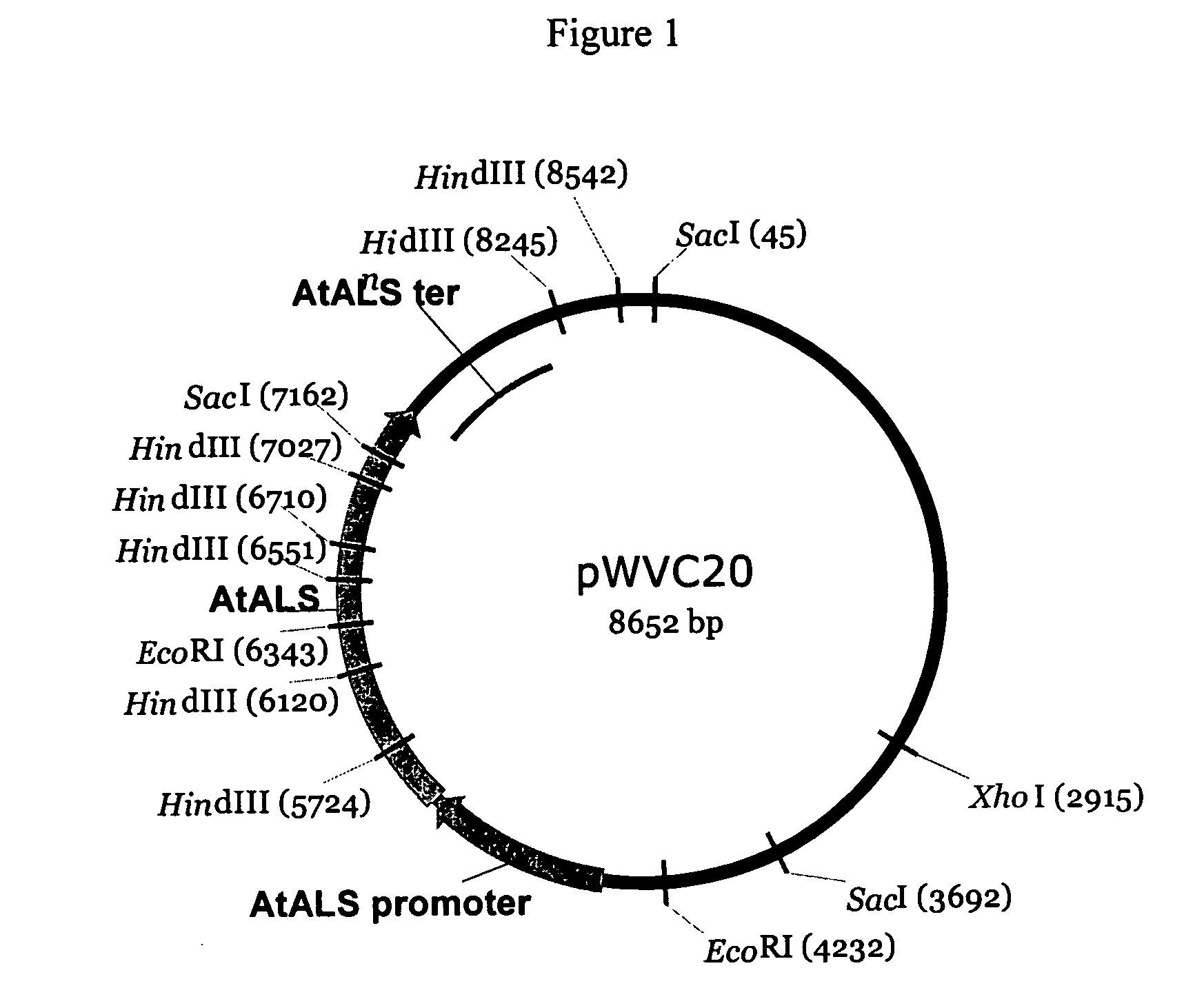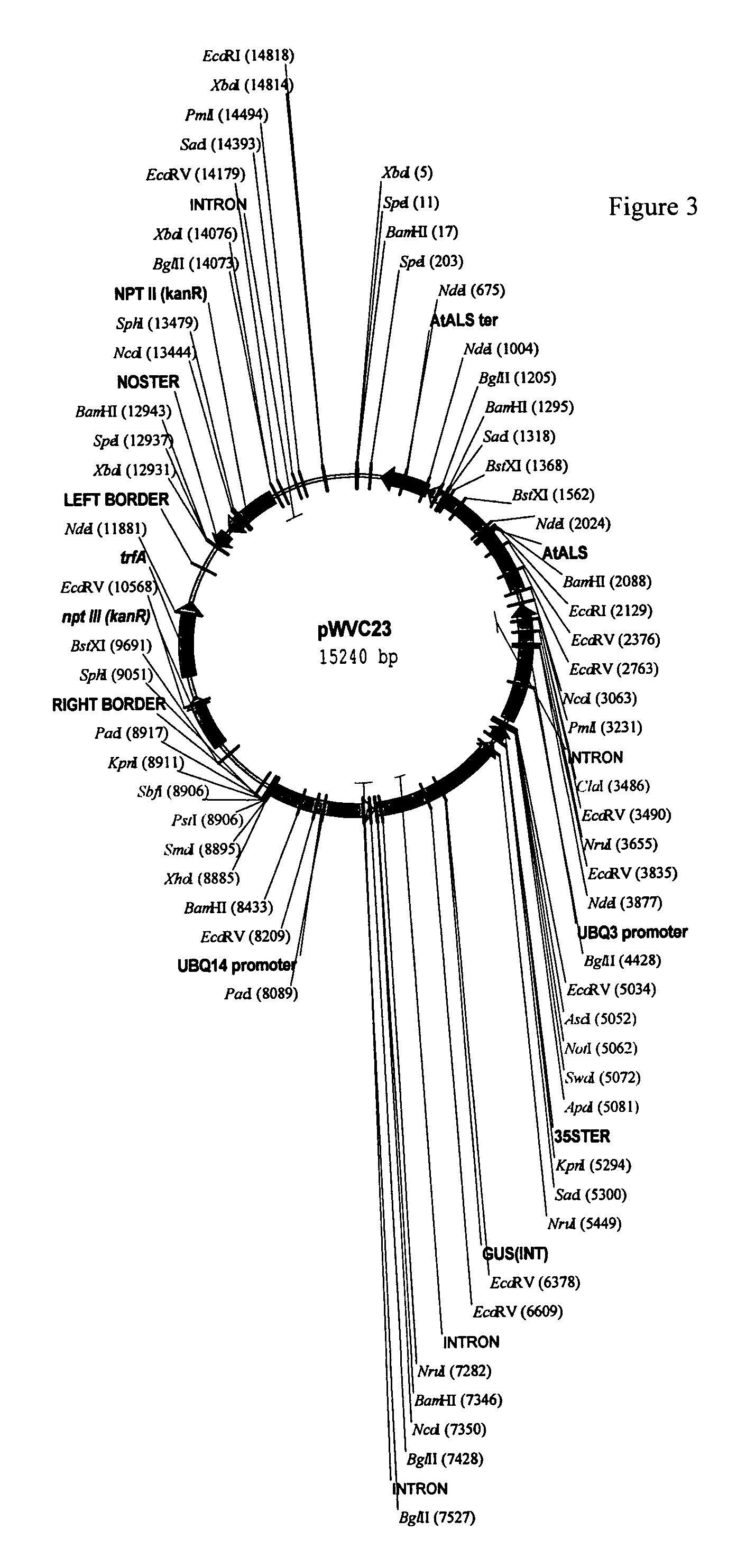Plant transformation and selection
a plant and gene technology, applied in the field of gene-dependent methods for plants, can solve the problems of limited transformation efficiency to 2.2% or lower, one line was difficult to propagate in culture or in the greenhouse, and the explants from elite genotypes cannot be used
- Summary
- Abstract
- Description
- Claims
- Application Information
AI Technical Summary
Benefits of technology
Problems solved by technology
Method used
Image
Examples
example 1
Plant Materials
[0143]All elite clones were maintained as shoot clumps in Magenta boxes and subcultured every 4-6 weeks. Shoot clumps were divided as needed and maintained as stock culture. Unless noted otherwise, all cultures were grown under shaded, cool fluorescent light with a light intensity of 30-40 μE / m2 / s with a photoperiod of 16 hours, and the temperature of the growth room is 21° C. Except for the selected E. dunnii clones, leaf explants were used for all selected clones.
[0144]Commercial E. dunnii elite clone DUN00001 were provided by Rijesa, a subsidiary of MeadWestvaco Brazil. Shoot clumps were maintained at 4 clumps per Magenta box. The preferred explant for these clones are tissues with advanced vascular tissues, such as intemodes, petioles and midribs.
[0145]E. grandis clones were provided by Rubicon, New Zealand. E. grandis clones were received as shoot clumps on solid medium. The clumps were transferred to Euc Maintenance medium (Table 1) with BA at 0.25-0.5 mg / l in M...
example 2
Construct
[0148]Two constructs were used for the transformation experiments: pWVZ20 and pWVR133. Binary plasmid pWVZ20 contains an herbicide resistant gene driven by a plant promoter and the β-glucuronidase (GUS) gene driven by a constitutive promoter between T-DNA borders. Binary plasmid pWVR133 contains the same herbicide resistant gene construct, but the GUS gene contains an intron and is driven by an actin promoter. GUS expression of pWVR133 only occurs in plant cells but not in bacterial cells. The Agrobacterium strain GV2260 (Deblaere et al. 1985) was used for the transformation studies. One of ordinary skill in the art would be able to use any binary construct having an herbicide resistant gene operably linked to a constitutive plant promoter.
example 3
Preparation of Agrobacterium for Transformation
[0149]Agrobacterium containing either pWVZ20 or pWVR133 were grown on YEP medium (10 g / l yeast extract, 10 g / l peptone and 50 mg / l NaCl, pH 7.0-7.2) for 3 days. A single colony from the plate was selected and grown in 20-50 ml liquid YEP medium with kanamycin at 100 mg / l and rifampicin 50 mg / l. Cultures were incubated overnight in a shaking incubator at 28° C. and 150 rpm. The over night culture with an OD of about 0.6-1.1 was spun down in a desktop centrifuge at 3000 g for 20 minutes and resuspended with Agrobacterium Induction Medium or AIM (WPM salts with glucose at 5 g / l, 250 μM acetosyringone, 2 mM phosphate buffer, and 0.05 M MES, pH 5.8) with an OD of about 0.6-1.1. Cultures were incubated for 25 minutes at 28° C. before infection. Bacterial concentration was determined before and after infection.
PUM
| Property | Measurement | Unit |
|---|---|---|
| concentration | aaaaa | aaaaa |
| concentration | aaaaa | aaaaa |
| concentration | aaaaa | aaaaa |
Abstract
Description
Claims
Application Information
 Login to View More
Login to View More - R&D
- Intellectual Property
- Life Sciences
- Materials
- Tech Scout
- Unparalleled Data Quality
- Higher Quality Content
- 60% Fewer Hallucinations
Browse by: Latest US Patents, China's latest patents, Technical Efficacy Thesaurus, Application Domain, Technology Topic, Popular Technical Reports.
© 2025 PatSnap. All rights reserved.Legal|Privacy policy|Modern Slavery Act Transparency Statement|Sitemap|About US| Contact US: help@patsnap.com



